Microsoft Windows Power Shell and SQL Server 2005 SMO - Part 4
 Microsoft Windows PowerShell and SQL Server 2005 SMO - Part 1
Microsoft Windows PowerShell and SQL Server 2005 SMO - Part 1
 Microsoft Windows PowerShell and SQL Server 2005 SMO - Part 2
Microsoft Windows PowerShell and SQL Server 2005 SMO - Part 2
 Microsoft Windows PowerShell and SQL Server 2005 SMO - Part 3
Microsoft Windows PowerShell and SQL Server 2005 SMO - Part 3
The MAK
Part I and Part II of this series showed simple Power Shell settings, SMO and WMI cmdlets. Part III instructs writing PowerShell and connecting to SQL Server. Part 4 will show you how to use PowerShell code to iterate file content and connect to other servers.
Imagine that we want to connect to different SQL Servers and collect the correct information like server name, version and all database names.
Step 1
We need to create a PowerShell script that displays all of the above information for a server. Create connect2.ps1 as shown below. [Figure 1.0]
param (
[string] $ SQLSERVER
)
$ SqlConnection = New-Object System.Data.SqlClient.SqlConnection
$ SqlConnection.ConnectionString =
"Server = $ SQLSERVER; Database = master; Integrated Security = True"
$ SqlCmd = New-Object System.Data.SqlClient.SqlCommand
$ SqlCmd.CommandText = "select 'Servername:
'+ @@ servername as Result union Select' Version: '+
@@ version as Result union select 'Database:' + name from sysdatabases as Result
order by Result desc "
$ SqlCmd.Connection = $ SqlConnection
$ SqlAdapter = New-Object System.Data.SqlClient.SqlDataAdapter
$ SqlAdapter.SelectCommand = $ SqlCmd
$ DataSet = New-Object System.Data.DataSet
$ SqlAdapter.Fill ($ DataSet)
$ SqlConnection.Close ()
$ DataSet.Tables [0]
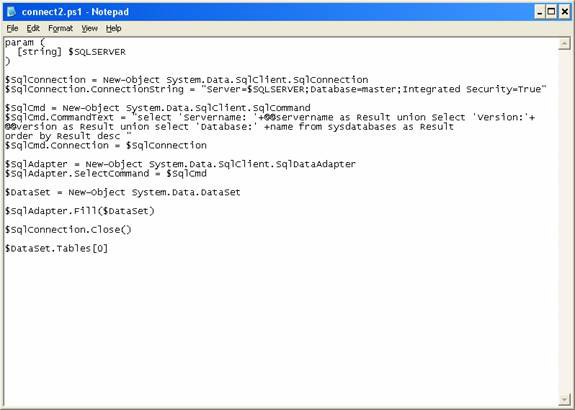
Figure 1.0
Step 2
Execute the following code: [Figure 1.1]
./connect2 "HOME"
Note : HOME is the server name. Please replace your server name.
Result
Result
------
Version: Microsoft SQL Server 2000 - 8.00.2039 (Intel X86) .
Servername: HOME
Database: VixiaTrack
Database: vixiadata
Database: vixia
Database: TrackEquipment
Database: test
Database: tempdb
Database: Sales2
Database: Sales
Database: pubs
Database: Northwind
Database: msdb
Database: model
Database: master
Database: Legacy_Vixia
Database: abc3
Database: abc2
Database: abc
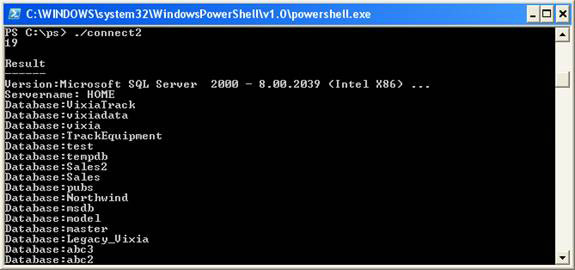
Figure 1.1
Step 3
Repeat through a file and display the contents of the file. Create the following loop1.ps1 code: [Figure 1.2] Also create the serverlist.txt file. [Figure 1.3]
param ([string] $ filename) $ computers = get-content $ filename foreach ($ computer in $ computers) {write-host $ computer} 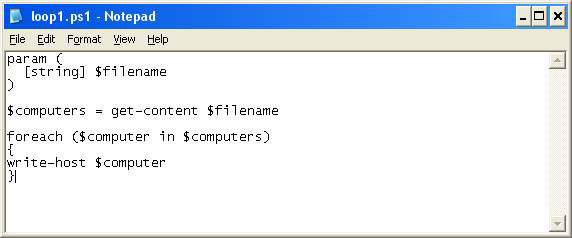
Figure 1.2
Serverlist.txt
HOME
HOMESQLEXPRESS
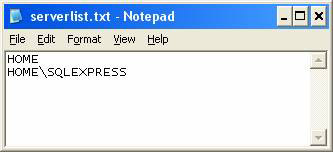
Figure 1.3
Please execute the loop1.ps1 code. [Figure 1.4]
./loop1 serverlist.txt
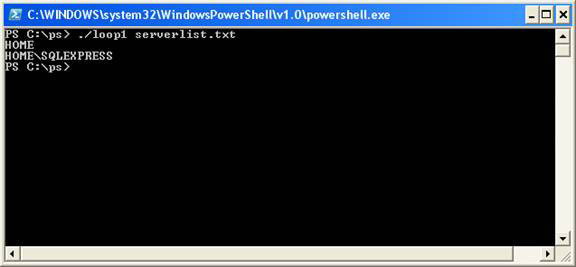
Figure 1.4
Step 4
Now combine connect2.ps1 and loop1.ps1 to obtain the names of SQL Server, SQL Server version and all database names listed on serverlist.txt.
Create connect3.ps1 as follows: [Figure 1.5]
param ([string] $ filename) $ SqlConnection = New-Object System.Data.SqlClient.SqlConnection $ computers = get-content $ filename foreach ($ computer in $ computers) {write-host "Details of the Server:" $ computer write-host "-----------------------------------"
$SqlConnection.ConnectionString = "Server=$computer;Database=master;Integrated Security=True" $SqlCmd = New-Object System.Data.SqlClient.SqlCommand $SqlCmd.CommandText = "select 'Servername: '+@@servername as Result union Select 'Version: ' $ SqlConnection.ConnectionString = "Server = $ computer; Database = master; Integrated Security = True" $ SqlCmd = New-Object System.Data.SqlClient.SqlCommand $ SqlCmd.CommandText = "select 'Servername:' + @@ servername as Result union Select 'Version:'
+@@version as Result union select 'Database:' +name from sysdatabases as Result order by Result desc " $SqlCmd.Connection = $SqlConnection $SqlAdapter = New-Object System.Data.SqlClient.SqlDataAdapter $SqlAdapter.SelectCommand = $SqlCmd $DataSet = New-Object System.Data.DataSet $SqlAdapter.Fill($DataSet) $SqlConnection.Close() $DataSet.Tables[0] } + @@ version as Result union select 'Database:' + name from sysdatabases as Result order by Result desc "$ SqlCmd.Connection = $ SqlConnection $ SqlAdapter = New-Object System.Data.SqlClient.SqlDataAdapter $ SqlAdapter.SelectCommand = $ SqlCmax.SelectCommand = $ SqlCmd $ DataSet = New-Object System.Data.DataSet $ SqlAdapter.Fill ($ DataSet) $ SqlConnection.Close () $ DataSet.Tables [0]} 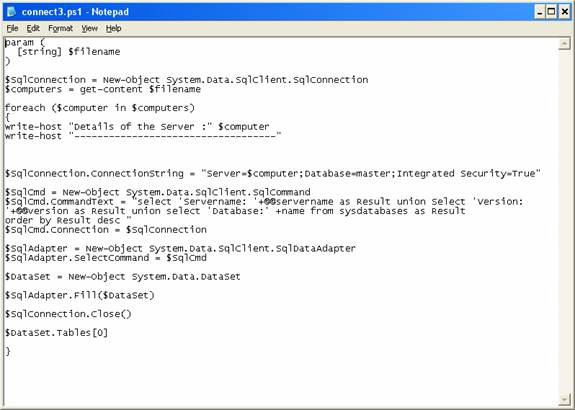
Figure 1.5
Step 5
Please execute the following code: [Figure 1.6]
./connect3 serverlist.txt
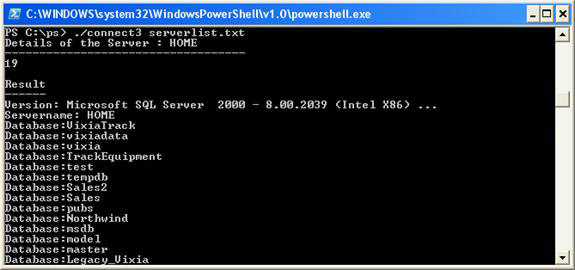
Figure 1.6
Result:
Details of the Server: HOME
-----------------------------------
19
Result
------
Version: Microsoft SQL Server 2000 - 8.00.2039 (Intel X86) .
Servername: HOME
Database: VixiaTrack
Database: vixiadata
Database: vixia
Database: TrackEquipment
Database: test
Database: tempdb
Database: Sales2
Database: Sales
Database: pubs
Database: Northwind
Database: msdb
Database: model
Database: master
Database: Legacy_Vixia
Database: abc3
Database: abc2
Database: abc
Details of the Server: HOMESQLEXPRESS
-----------------------------------
11
Version: Microsoft SQL Server 2005 - 9.00.2047.00 (Intel X86) .
Servername: HOMESQLEXPRESS
Database: XMLTest
Database: VixiaTrack
Database: test
Database: tempdb
Database: msdb
Database: model
Database: master
Database: AdventureWorks
Database: admin
Now create a similar PowerShell code, using SQL Server SMO.
Step 1
Generate code connect4.ps1 PowerShell [Figure 1.7]
param ([string] $ filename) [reflection.assembly] :: LoadWithPartialName ("Microsoft.SqlServer.Smo") $ SqlConnection = New-Object System.Data.SqlClient.SqlConnection $ computers = get-content $ filename foreach ($ computer in $ computers) {write-host "Details of the Server:" $ computer write-host "----------------------------- ------ "$ Server = new-object (" Microsoft.SqlServer.Management.Smo.Server ")" $ computer "write-host" Server Version: "$ Server.Serverversion write-host" Server Name: " $ Server.Information.VersionString foreach ($ database in $ Server.databases) {write-host "Database:" $ database.name}} 
Figure 1.7
Step 2
Execute the code connect4.ps1 created above [Figure 1.8]
./connect4 serverlist.txt
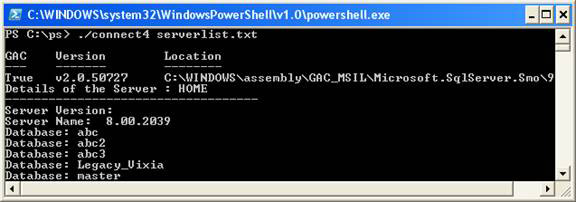
Figure 1.8
Result
PS C: ps> ./connect4 serverlist.txt
GAC Version Location
--- ------- --------
True v2.0.50727 C: WINDOWSassemblyGAC_MSILMicrosoft.SqlServer.Smo9 .
Details of the Server: HOME
-----------------------------------
Server Version:
Server Name: 8.00.2039
Database: abc
Database: abc2
Database: abc3
Database: Legacy_Vixia
Database: master
Database: model
Database: msdb
Database: Northwind
Database: pubs
Database: Sales
Database: Sales2
Database: tempdb
Database: test
Database: TrackEquipment
Database: vixia
Database: vixiadata
Database: VixiaTrack
Details of the Server: HOMESQLEXPRESS
-----------------------------------
Server Version:
Server Name: 9.00.2047.00
Database: admin
Database: AdventureWorks
Database: master
Database: model
Database: msdb
Database: tempdb
Database: test
Database: VixiaTrack
Database: XMLTest
Conclude
Part IV introduces how to use the PowerShell script to loop through the contents of a file and connect to different servers. This section also describes how to do the same using SQL Server SMO.
 Microsoft Windows PowerShell and SQL Server 2005 SMO - Part 5
Microsoft Windows PowerShell and SQL Server 2005 SMO - Part 5
 Microsoft Windows PowerShell and SQL Server 2005 SMO - Part 6
Microsoft Windows PowerShell and SQL Server 2005 SMO - Part 6
 Microsoft Windows PowerShell and SQL Server 2005 SMO - Part 7
Microsoft Windows PowerShell and SQL Server 2005 SMO - Part 7
 Microsoft Windows PowerShell and SQL Server 2005 SMO - Part 8
Microsoft Windows PowerShell and SQL Server 2005 SMO - Part 8
 Microsoft Windows PowerShell and SQL Server 2005 SMO - Part 9
Microsoft Windows PowerShell and SQL Server 2005 SMO - Part 9
 Microsoft Windows PowerShell and SQL Server 2005 SMO - Part 10
Microsoft Windows PowerShell and SQL Server 2005 SMO - Part 10
 Microsoft Windows PowerShell and SQL Server 2005 SMO - Part 11
Microsoft Windows PowerShell and SQL Server 2005 SMO - Part 11
You should read it
- Move the Tempdb and Master databases on SQL Server
- Database monitoring in MS SQL Server
- Use the ALTER DATABASE command to migrate DATABASE in SQL Server
- SQL Server setup is always available
- What is MS SQL Server?
- Network basics: Part 3 - DNS Server
- How to Set Up a Microsoft SQL Server Database in Docker on Linux
- Microsoft Windows PowerShell and SQL Server 2005 SMO - Part 9
May be interested
- Test SQL Server with Windows PowerShell - Part 1
 instead of using vbscript, bat files, or sql client implementations, ... we'll show you the power of windows powershell in checking sql servers status.
instead of using vbscript, bat files, or sql client implementations, ... we'll show you the power of windows powershell in checking sql servers status. - Test SQL Server with Windows PowerShell - Part 5
 in this part 5, we will check whether we can connect to sql server and see if we can query some properties related to sql server.
in this part 5, we will check whether we can connect to sql server and see if we can query some properties related to sql server. - Microsoft: Windows Server does not support ARM
 microsoft currently has no plans to develop a dedicated operating system version for the server running the arm architecture processor.
microsoft currently has no plans to develop a dedicated operating system version for the server running the arm architecture processor. - Steps to install Microsoft SQL Server on Windows 10
 instructions on how to install microsoft sql server on windows 10, a database management system from microsoft. install sql server and ssms is a gui tool to support sql server manipulation
instructions on how to install microsoft sql server on windows 10, a database management system from microsoft. install sql server and ssms is a gui tool to support sql server manipulation - Microsoft Windows PowerShell and SQL Server 2005 SMO - Part 11
 part 10 of this article series showed how to use powershell scripts in conjunction with smo and parameters to create sql server scripts. in this section, we will show you how to use powershell cmdlets in conjunction with the sql server client and output saving to export to a text file or xml file.
part 10 of this article series showed how to use powershell scripts in conjunction with smo and parameters to create sql server scripts. in this section, we will show you how to use powershell cmdlets in conjunction with the sql server client and output saving to export to a text file or xml file. - Why use Microsoft Power Query for Excel
 if you're looking for a powerful new way to manage data, microsoft excel for windows now has software built in to help you with that, which is microsoft power query. this is a new tool that helps you take control of your spreadsheets more than ever.
if you're looking for a powerful new way to manage data, microsoft excel for windows now has software built in to help you with that, which is microsoft power query. this is a new tool that helps you take control of your spreadsheets more than ever. - Microsoft Windows PowerShell and SQL Server 2005 SMO - Part 8
 in this article, i will show you how to use powershell in conjunction with smo to display object properties for all sql server objects.
in this article, i will show you how to use powershell in conjunction with smo to display object properties for all sql server objects. - Configure Windows Server 2008 to remotely access SSL VPN Server (Part 3)
 in the previous two articles of this series on how to create an ssl vpn server on windows server 2008, we introduced the basics of vpn connection issues, then went into the configuration of the server. . in this process,
in the previous two articles of this series on how to create an ssl vpn server on windows server 2008, we introduced the basics of vpn connection issues, then went into the configuration of the server. . in this process, - Test SQL Server with Windows PowerShell - Part 6
 part 6 will show you how to check all existing databases in the sql server instance and query the database properties.
part 6 will show you how to check all existing databases in the sql server instance and query the database properties. - Free Microsoft Labs repositories include: Windows Server, SQL Server and many other services
 this free microsoft labs repository includes quite a number of microsoft services such as windows server, sql server, office, windows, forefont, system center. you only need a microsoft account to access these labs.
this free microsoft labs repository includes quite a number of microsoft services such as windows server, sql server, office, windows, forefont, system center. you only need a microsoft account to access these labs.










 Create upload file with VB.NET
Create upload file with VB.NET New points in SQL 2008 (Part 1)
New points in SQL 2008 (Part 1) Query XML data from a table with XML data type
Query XML data from a table with XML data type Improvements in ASM
Improvements in ASM The ten biggest errors developers have with databases
The ten biggest errors developers have with databases Use and manage Database Mail
Use and manage Database Mail